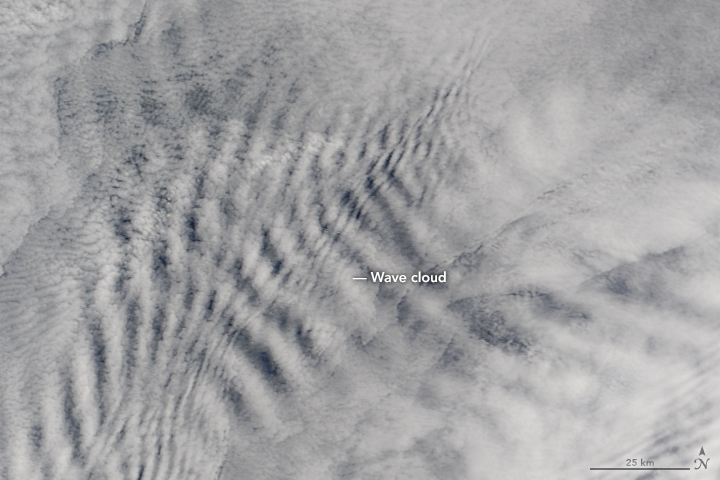Cloud Wakes Behind the Prince Edward Islands

acquired November 5, 2015
Located about 1,000 kilometers (620 miles) from South Africa, the Prince Edward Islands jut out of the southern Indian Ocean at a remote point between Africa and Antarctica. The larger of the two islands—Marion Island—reaches an elevation of 1,230 meters (4,040 feet) at its highest peak. A volcanic mountain on Prince Edward Island reaches 672 meters (2,205 feet). Both islands have volcanic origins.
As shown by this natural-color satellite image, the peaks are high enough to disrupt the air masses and clouds flowing around them. On November 5, 2015, the Moderate Resolution Imaging Spectroradiometer (MODIS) on NASA’s Terra satellite captured this image of mountain-wave clouds flowing in a northeasterly direction on the lee side of the islands. See the lower image for a more detailed view.
Wave clouds can form when stable air flows over a raised land form. In this case, the island generated wave motions in the air passing over it, much like the bow of a ship creates ripples as it cuts through water. The crests of these lee waves raised and cooled the air enough to form clouds, while the troughs remain too low and warm for cloud formation. Seen from above, the result is a distinctive banded pattern.
Cloud Wakes behind Amsterdam Island
More than 3,000 kilometers (2,000 miles) from any continent, Amsterdam
Island pokes out from the southern Indian Ocean at a point between
Africa, Australia, and Antarctica.
From NASA Earth Observatory.
From NASA Earth Observatory.
NASA image by Jeff Schmaltz, LANCE/EOSDIS Rapid Response. Caption and image annotations by Adam Voiland.






2 comments:
Rajesh sir ,rain didnt occur till now in roha,or elsewhere.is your forecast proper for wednesday or a drastic change?
abizer: There has been some isolated rainfall in North Konkan on Wed evening. Did not increase as expected though. The rains were estimated on the basis of the Low in South Arabian Sea which had started moving North. Some international models also presumed some rain on the basis.
Low is now embedded in the trough.
You cannot term it as a "drastic change".
Post a Comment